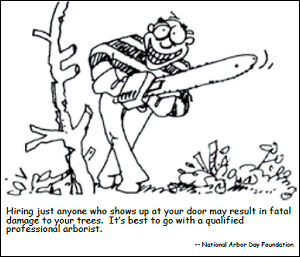Green Horizons
Volume 19, Number 1Winter 2015
Dealing with storm damage
By Eugene L. Brunk | MDC Retiree
 |
When a storm passes through and damages our property, most people want to deal with the damage as soon as possible, so they can "get things back the way they were." We don't like to have our lives disrupted any longer than absolutely necessary. Certainly, we need to begin the cleanup as soon as possible with regard to those actions necessary to provide for safety to ourselves and others, and also to prevent further damage to our homes from additional environmental factors such as rain, snow, etc. Fortunately, it is not always necessary to immediately try to remedy damage done to our landscape trees; and in many cases, it is best to take a more cautious approach so we do not do irreparable, long-term damage to the residual trees that survived the storm.
Cleanup and recovery of storm damaged trees can be bewildering. Some injured trees can be treated and repaired to maintain their health and value to your property. Others should be removed completely, if they cannot be successfully repaired. The process of dealing with storm damaged trees consists of three phases: making things safe, assessing the damage, and doing the recovery work.
Reducing hazards should be the first, and most immediate, action in order to make things safe. Many times damaged trees are entangled in downed electrical lines and it is essential that this danger be removed. However, homeowners should not attempt this work. It should only be done by the electrical provider, or persons qualified by the provider to do the work. If there are no electrical hazards present, or they have been removed/repaired, the first step is to remove trees, limbs, etc. that have fallen on your home or are blocking access. Also, look for hanging limbs, or other debris, that could drop on your home or family. They should be removed immediately: Remember, safety first!
Any other tree damage can wait until the immediate crisis has passed. Take your time to assess the damage, or have it assessed by an arborist, so you will have an idea of the magnitude and potential cost of any repair work that is indicated. Be patient. Develop a plan for dealing with each damaged tree. Taking your time will allow for a more deliberative process, and should help in making decisions about which trees should be removed; which is often one of the most heart wrenching decisions a homeowner must make. Again, professional advice can help you determine a course of action, if you are not familiar with the technical aspects involved.
Once a plan is developed to deal with the damage, it is probably best to hire a certified arborist to do the work. Check with your insurance carrier. Many home owners policies provide coverage of storm damage to trees, and could significantly reduce the out-of-pocket costs to you. If your policy has no such coverage, get bids for the work to assure competitive prices.
Do not just let anyone who owns a chainsaw work on your trees. It could result in fatal damage to your trees! Unless you are competent yourself and know what you're doing, it's best to hire a qualified, professional, certified and insured arborist. It's the best value in the long run, and the best medicine for your injured trees.